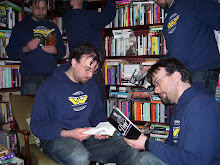Perec (1936-1982), a member of the Oulipo group who wrote using various formal restraints on their books' structures, seems to have begun this book on a dare, and then thoroughly enjoyed its creation. It's a kind of mystery novel about a man who wakes up with a fundamental sense of wrongness: he's one of the few who notices that 'e' seems to have vanished from the universe. When he himself vanishes soon afterwards, his friends try to track him down, using the various strange documents he has left behind. Along the way they encounter clever 'e'-less remixes of various great works of literature, including Moby Dick, Hamlet's 'To be or not to be' soliloquoy, Shelley's Ozymandias, and Poe's The Raven.
The English translation from the French was done by Gilbert Adair. Aside from Love and Death on Long Island, I've found Adair's own novels deeply unsatisfying. They take intriguing ideas and ruin them with characters who have all the psychological realism of a Shakespeare play performed by kindergarten students. This translation, though, must count as a masterpiece. After all, it was probably even harder to write than the original novel: Perec, at least, could take the story where he liked, whereas Adair was stuck with the very narrow aparameters of converting one specific text from one language to another without ever using the letter 'e'.
The new Vintage Classics edition of A Void also has a clever cover, by Jo Walker. Aside from the publisher/author names in the top corner, it consists only of the letter 'e'.

This cunning use of negative space is quite uncommon, and all the more effective for it.





4 comments:
I'm a bit of an Adair fan, I must admit, though his decision to expand the Evadne Mount novel The Act of Roger Murgatroyd into a trilogy has to be regarded as rash.
Yes, his characters are not psychologically rich, but his books are much more about the ideas and the conception/execution than the characters anyway. I particularly rate The Death of the Author (soon to be reissued by Melville House in their Art of the Novella series - I look forward to your post on those fine handsome volumes!) and Buenas Noches Buenos Aires. Even more schematic stuff like The Key of the Tower has its Hitchcockian charm.
'The Death of the Author' looks interesting, I have to say. 'Buenas Noches...' made me very cross, though.
I actually wrote about the lovely Art of the Novella series elsewhere, at Bookslut: http://www.bookslut.com/small_but_perfectly_formed/2005_04_005347.php
That was about the books themselves, rather than the covers, but you're right, there's a post in their design too.
Ah yes, I remember reading that Bookslut post when I was imbibing the sights, smells and sounds of all things Melville House last year - didn't realise it was by you then (largely as I only discovered your blog two days ago...).
And while we're on the subject, what about Bloomsbury Classics? Did you ever get those handsome little hardbacks, covers by Jeff Fisher, in Australia? They were published in the UK in the mid-90s, and I still cherish my few dozen.
Yes, I love those little things: I've got a few, mainly the poem collections, plus a couple of the short story collections. Jeff Fisher is/was Australian, I believe--haven't seen so much of his work recently, but perhaps that's what happens when you're so in vogue and do the cover for every second book that comes out for a while.
Post a Comment